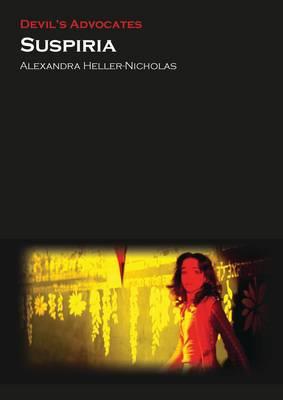| Alexandra Heller-Nicholas Suspiria (Devil’s Advocates) UK: Auteur Publishing, 2015 ISBN: 978-0993238475 AU$27.95 (pb) 120pp (review copy supplied by Auteur publishing) |
 |
Almost four decades after its initial release, Dario Argento’s Suspiria (1977) continues to demand attention. In her contribution to the Devil’s Advocates series, Alexandra Heller-Nicholas has crafted an insightful exploration of this Italian cult horror film in Suspiria (2015). The study is divided into three sections: locating the film within the horror canon, a close analysis of the film, and its history of reception. Heller-Nicholas combines in-depth visual analysis with fascinating technical and contextual details, rendered throughout in an expressive prose that captures the entrancing quality of the film itself.
The plot of Suspiria is almost disconcertingly straightforward: American dancer Suzy enrols at the prestigious Tanzakademie in Germany, which is governed by a coven of witches. Heller-Nicholas rebuffs any potential criticism of the absence of a complex plot, proposing that it is this refusal to privilege narrative that allows Argento to fashion such a daring film. She insists that Suspiria “invites us to surrender to the illogical, to be seduced by the spectacle… sensory excesses are so overwhelming that they smother any intellectual strategies its audience may have”. To support this idea of Argento’s unrelenting focus on spectacle and sensations, Heller-Nicholas turns to Tom Gunning’s idea of the ‘cinema of attractions’ and Laura U. Marks’ theory of ‘haptic visuality’. Together, these encourage her belief that the “aggressive stylistic hyperactivity” of Suspiria makes it a film that needs to be experienced through the body.
There is an overwhelming sense of artifice in this film, so much so that it generates a veritable audio-visual overload. Hypnotised, we share in Suzy’s drugged and dazed state as we immerse ourselves as viewers. Heller-Nicholas explores this through the formal qualities of Argento’s “bold, hallucinatory style”, notably colour, light and sound. The visual aesthetic of Suspiria is dominated by Argento’s treatment of colour and light, with scenes bathed in saturated primary colours that draw attention to deep shadows. Heller-Nicholas draws out comparisons to Argento’s other work, to film noir and giallo films, and also to the pre-cinematic tradition of shadows puppetry. Significantly, she has included a perceptive exploration of the vital role of sound in Suspiria, considering how sound and image are closely bound. She points to how the “manic musicality” engenders mood and enhances the narrative, with sounds like hisses of “witch!” and the clicking of heels punctuating the soundtrack, scored by Italian prog-rock band Goblin.
Heller-Nicholas discusses interesting technical aspects of the film, including the fact that it was printed on an old-fashioned technicolour printer and was the last film to be dye transferred. She looks at the collaboration between Argento and the actress and screenwriter Daria Nicolodi, who not only co-wrote this script but presented him with the story of the Three Mothers. The book notes the pedigree of the cast, including Jessica Harper’s work with Brian de Palma, Joan Bennet’s with Fritz Lang and Alida Valli’s with Antonioni, Bava and Hitchcock. There is also a section on the crew, an often overlooked aspect of film criticism, and Heller-Nicholas has included her extensive interview with the cinematographer Luciano Tovoli as an appendix. Suspiria also addresses popular apocrypha surrounding the film, including references to the flash of the McDonald’s arches from the taxi, the fact that Harper was a trained dancer who never actually danced in the film, and that the opening scene was (loosely) recreated in Argento’s direction of a Trussardi runway show of 1986.
Suspiria is a film that is loaded with influences. Heller-Nicholas traces Argento’s visual and literary inspirations, including the films of Mario Bava and Sergio Leone, the art of M.C. Escher and Oskar Kokoschka, the writings of Edgar Allan Poe and fairy tales such as Bluebeard. Suspiria is especially indebted to Disney’s Snow White and the Seven Dwarfs (1937). Yet, the most important reference is Thomas De Quincey’s Suspiria de profundis, which was the source for Argento’s Three Mothers trilogy: Suspiria, Inferno (1980) and The Mother of Tears (2007). What is particularly notable here is the way that Heller-Nicholas draws out art historical references Suspiria, from the recognisable Aubrey Beardsley illustrations to the less obvious secular stained glass windows or the German Expressionist tilt of a window.
Heller-Nicholas convincingly positions Suspiria as a significant film both within the horror tradition and broader cinematic history. While Argento is an immensely popular Eurohorror director, the so-called “Italian Hitchcock”, his reach extends well beyond this genre. Suspiria achieved both critical and commercial success in Europe, the United States as well as the Asia-Pacific. Heller-Nicholas considers its legacy, especially in recent films such as Amer (Hélène Cattet and Bruno Forzani, 2009) from Belgium, Livide (Alexandre Bustilloa and Julien Maury, 2011) from France, and Another (Jason Bognacki, 2014) from the United States. She also acknowledges the complicated and problematic gender politics at play in Argento’s work. His films are frequently accused of expressing a deep-set misogyny, with women treated as beautiful objects to be murdered in brutal and bloody ways. While not excusing this issue, Heller-Nicholas turns the question from what he thinks of women to what women think of him. In particular, she emphasises the importance of the female ensemble cast, especially one which lacks the gratuitous nudity present in the slasher genre. Heller-Nicholas offers a persuasive insight into why Suspiria remains popular, delving into the “exquisite terror” of the film which is simultaneously mesmerising and impenetrable.
